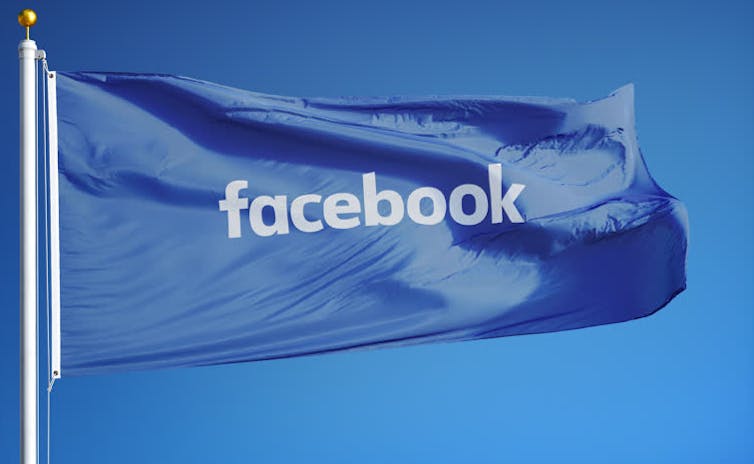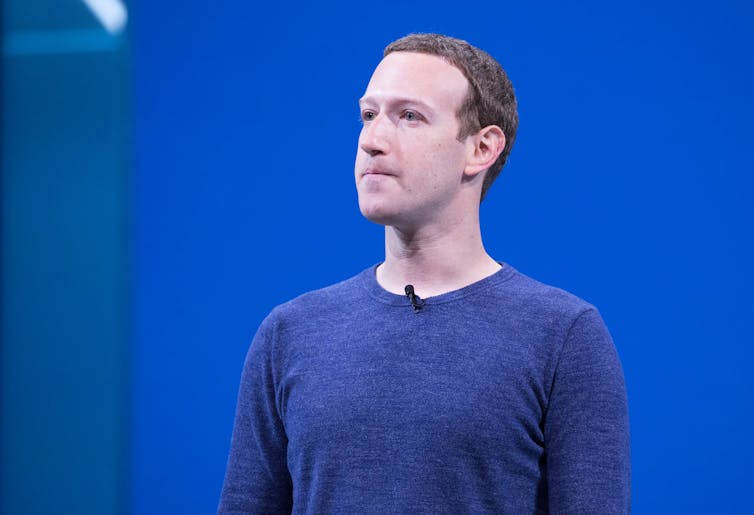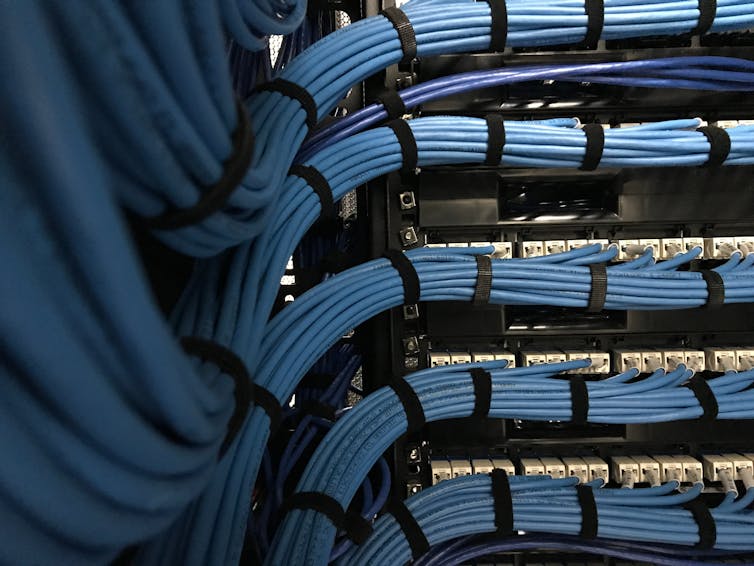Stop blaming video games for mass killings

In the wake of the El Paso shooting on Aug. 3 that left 22 dead and dozens injured, a familiar trope has reemerged: Often, when a young man is the shooter, people try to blame the tragedy on violent video games and other forms of media.
This time around, Texas Lt. Gov. Dan Patrick placed some of the blame on a video game industry that “teaches young people to kill.” Republican House Minority Leader Kevin McCarthy of California went on to condemn video games that “dehumanize individuals” as a “problem for future generations.” And President Trump pointed to society’s “glorification of violence,” including “gruesome and grisly video games.”
These are the same connections a Florida lawmaker made after the Parkland shooting in February 2018, suggesting that the gunman in that case “was prepared to pick off students like it’s a video game.”
But, as a researcher who has studied violent video games for almost 15 years, I can state that there is no evidence to support these claims that violent media and real-world violence are connected.
As far back as 2011, the U.S. Supreme Court ruled that research did not find a clear connection between violent video games and aggressive behavior. Criminologists who study mass shootings specifically refer to those sorts of connections as a “myth.” And in 2017, the Media Psychology and Technology division of the American Psychological Association released a statement I helped craft, suggesting reporters and policymakers cease linking mass shootings to violent media, given the lack of evidence for a link.
A history of a moral panic
So why are so many policymakers inclined to blame violent video games for violence? There are two main reasons.
The first is the psychological research community’s efforts to market itself as strictly scientific. This led to a replication crisis instead, with researchers often unable to repeat the results of their studies. Now, psychology researchers are reassessing their analyses of a wide range of issues – not just violent video games, but implicit racism, power poses and more.
The other part of the answer lies in the troubled history of violent video game research specifically.
Beginning in the early 2000s, some scholars, anti-media advocates and professional groups like the APA began working to connect a methodologically messy and often contradictory set of results to public health concerns about violence. This echoed historical patterns of moral panic, such as 1950s concerns about comic books and Tipper Gore’s efforts to blame pop and rock music in the 1980s for violence, sex and Satanism.
Particularly in the early 2000s, dubious evidence regarding violent video games was uncritically promoted. But over the years, confidence among scholars that violent video games influence aggression or violence has crumbled.
Reviewing all the scholarly literature
My own research has examined the degree to which violent video games can – or can’t – predict youth aggression and violence. In a 2015 meta-analysis, I examined 101 studies on the subject and found that violent video games had little impact on kids’ aggression, mood, helping behavior or grades.
Two years later, I found evidence that scholarly journals’ editorial biases had distorted the scientific record on violent video games. Experimental studies that found effects were more likely to be published than studies that had found none. This was consistent with others’ findings. As the Supreme Court noted, any impacts due to video games are nearly impossible to distinguish from the effects of other media, like cartoons and movies.
Any claims that there is consistent evidence that violent video games encourage aggression are simply false.
Spikes in violent video games’ popularity are well-known to correlate with substantial declines in youth violence – not increases. These correlations are very strong, stronger than most seen in behavioral research. More recent research suggests that the releases of highly popular violent video games are associated with immediate declines in violent crime, hinting that the releases may cause the drop-off.
The role of professional groups
With so little evidence, why are lawmakers still trying to blame violent video games for mass shootings by young men? Can groups like the National Rifle Association seriously blame imaginary guns for gun violence?
A key element of that problem is the willingness of professional guild organizations such as the APA to promote false beliefs about violent video games. (I’m a fellow of the APA.) These groups mainly exist to promote a profession among news media, the public and policymakers, influencing licensing and insurance laws. They also make it easier to get grants and newspaper headlines. Psychologists and psychology researchers like myself pay them yearly dues to increase the public profile of psychology. But there is a risk the general public may mistake promotional positions for objective science.
In 2005 the APA released its first policy statement linking violent video games to aggression. However, my recent analysis of internal APA documents with criminologist Allen Copenhaver found that the APA ignored inconsistencies and methodological problems in the research data.
The APA updated its statement in 2015, but that sparked controversy immediately: More than 230 scholars wrote to the group asking it to stop releasing policy statements altogether. I and others objected to perceived conflicts of interest and lack of transparency tainting the process.
It’s bad enough that these statements misrepresent the actual scholarly research and misinform the public. But it’s worse when those falsehoods give advocacy groups like the NRA cover to shift blame for violence onto non-issues like video games. The resulting misunderstanding hinders efforts to address mental illness and other issues, such as the need for gun control, that are actually related to gun violence.
This is an updated version of an article originally published on Feb. 16, 2018.
Christopher J. Ferguson, Professor of Psychology, Stetson University
This article is republished from The Conversation under a Creative Commons license. Read the original article.
Driverless cars are going to disrupt the airline industry

As driverless cars become more capable and more common, they will change people’s travel habits not only around their own communities but across much larger distances. Our research has revealed just how much people’s travel preferences could shift, and found a new potential challenge to the airline industry.
Imagine someone who lives in Atlanta and needs to travel to Washington, D.C., for business. This is about a 10-hour drive. A flight takes about two hours, assuming no delays. Add to that the drive to the airport, checking in, the security line and waiting at the gate. Upon arrival in D.C., it may take another 30 minutes to pick up any checked bags and find a rental car – and even more time to drive to the specific destination. The average person would estimate a total travel time of four to five fours. Most people would choose to fly instead of driving themselves.
However, if they could have a fully driverless car take them there, the choice changes. Passengers could eat, drink, work and sleep during the 10-hour drive. They could leave whenever they want, and pack whatever they want – including liquids and pocketknives – with no searches or scans. When they get to D.C., they wouldn’t have to find a rental car and navigate to the actual place they’re going.
Which would you choose? Now imagine the self-driving car has a reclining seat with actual legroom, or even a bed. It’s more than a little tempting.
What do consumers say?
As experts in public opinion research, we know that the American public loves how quickly flights can cover large distances, but hates the security checks, long lines, delays, risk of losing baggage and overall hassle of the flying experience.
We also know that at the moment, most people are reluctant to ride in driverless vehicles – including school buses and even ambulances that could speed their treatment in an emergency. However, our data also shows that as people learn about the benefits of driverless cars, they become more accepting of the new technology. Over time, people will feel comfortable using autonomous cars (and ambulances), just like they adjusted to riding in the first automobiles.
A future with driverless cars means people will have more options to avoid driving on their own, beyond trains and buses.
In our study, we showed people trips of different lengths and asked them to choose whether they would rather drive themselves, take a flight or ride in a self-driving car. In general, the data indicated that people always preferred driverless vehicles over manual driving. Taking a driverless car got even more attractive if people were told that after flying, they would need a rental car in their destination city.
On short trips, with a five-hour drive, two-thirds of people would rather drive themselves. That didn’t change much when they were offered a self-driving car, unless they were told they would need a car in their destination city. Then nearly three-quarters of people preferred a self-driving car to flying.
As trips got longer, people were increasingly likely to prefer flying, but self-driving cars were still a compelling option. On the longest trips we asked about, with a 45-hour drive, only about one in 10 people preferred driving themselves – but that changed to one in six when the option was to have a car drive itself.
In follow-up work, we’re looking at how the costs of each transportation method might affect consumers’ choices – including whether they’re traveling alone or in a group with friends or family members.
How will this affect the airlines?
Losing even one in 10 customers would substantially reduce airlines’ revenue. They don’t make much money on each flight as it is; less income would likely cause them to shrink their service, flying fewer routes less frequently.
The problem wouldn’t just be customers who chose not to fly. Some passengers might split trips between self-driving cars and airplanes, which would further reduce airlines’ revenue. For instance, a person in Savannah, Georgia, who wants to go to London could choose to change planes in Atlanta – or take a self-driving car to the Atlanta airport, and skip the layover.
These changes could substantially change the aviation industry, with airlines ordering fewer airplanes from manufacturers, airports seeing fewer daily flights and lower revenue from parking lots, and even airport hotels hosting fewer guests. The future of driverless cars is appealing to consumers – which means the future of commercial flight is in danger.
[ Deep knowledge, daily. Sign up for The Conversation’s newsletter. ]![]()
Stephen Rice, Professor of Human Factors, Embry-Riddle Aeronautical University and Scott Winter, Assistant Professor of Graduate Studies, Embry-Riddle Aeronautical University
This article is republished from The Conversation under a Creative Commons license. Read the original article.
<With cryptocurrency launch, Facebook sets its path toward becoming an independent nation

Facebook has announced a plan to launch a new cryptocurrency named the Libra, adding another layer to its efforts to dominate global communications and business. Backed by huge finance and technology companies including Visa, Spotify, eBay, PayPal and Uber – plus a ready-made user base of 2 billion people around the world – Facebook is positioned to pressure countries and central banks to cooperate with its reinvention of the global financial system.
In my view as a social media researcher and educator, Facebook CEO Mark Zuckerberg is clearly seeking to give his company even more political power on a global scale, despite the potential dangers to society at large. In a sense, he is declaring that he wants Facebook to become a virtual nation, populated by users, powered by a self-contained economy, and headed by a CEO – Zuckerberg himself – who is not even accountable to his shareholders.
Facebook hasn’t behaved responsibly in the past, and is still wrestling with significant public concerns – and investigations – about its privacy practices, information accuracy and targeted advertising. Therefore, it’s important to see through the hype. People must consider who is reshaping the world, and whether they are doing it in the best interests of humankind – or whether they are just seeking to benefit the new class of elite technology executives.
Humanity needs ethical leadership, and time to think through the potential repercussions of rapid technological change. That’s why, in my view, Facebook’s cryptocurrency should be blocked by financial regulators until its design has been proved to be safe for all of global society.

Understanding Libra
Technology companies are interested in a global currency that is native to the internet. That could allow companies like Facebook and Twitter to bring in more users to their platforms, and collect money from businesses who want to join the new system. They also want to siphon off business from the existing financial services industry. That sector is worth trillions of dollars, is enormously profitable, and yet has struggled to implement its own digital currency.The company may be counting on increased public interest in cryptocurrencies and financial technologies, and its market strength, to overcome objections. However, I don’t believe Facebook should be allowed to wreck the global financial system like it has, as many see it, wrecked global communications.
Speeding global exchange
There is definitely a need for smoother, faster and cheaper ways to send money around the world, and to provide access to financial services to the many people who do not have formal bank accounts. There is real potential to Libra, but there are likely to be ways to improve even more, developing a payment system that better serves the world as a whole.At least at the moment, the Libra is being designed as a form of electronic money linked to many national currencies. That has raised fears that Libra might someday be recognized as a sovereign currency, with Facebook acting as a “shadow bank” that could compete with the central banks of countries around the world.
It doesn’t help that Facebook is already positioning itself to evade regulatory scrutiny by creating a corporate subsidiary that will join an ostensibly independent governing body for the Libra.
To protect consumers, regulators should look carefully at whether the new system supporting the Libra is sound. It may be that an entirely new set of financial rules and regulations is needed to shield the existing financial system from harm if the Libra becomes more popular than national currencies. At the very least, governments need to proceed slowly and carefully when new products may introduce systemic risks into our environment. Even the CEO of Google has acknowledged that. In my opinion, Libra’s planned launch in 2020 does not allow enough time to fully vet this technology and its risks.
Protecting the global financial system
Financial regulations have developed over time to encourage trust between unknown parties, and to protect regular customers from fraudsters and corporate greed. There are also rules that help governments prevent and detect transactions that support crime and terrorism.This is not to say that all payments and purchases should be tied to a known entity online or in real life. Cash and anonymity is also a civil right and is key to privacy and personal freedoms.
As new digital financial services, methods of electronic payment and currencies develop and become popular, they should not be allowed to undermine longstanding financial safety systems, even in the name of smoother, cheaper transactions.
My concern is not just about large-volume transactions. Facebook has shown how even small amounts of money can buy microtargeted ads with the power to influence public opinion and election outcomes in the U.S. and around the world.
Product design and risk assessment
Facebook has a long history of questionable business models and privacy practices. The public, and their representatives in government – including elected officials, financial regulators and central bank authorities – should carefully scrutinize all aspects of Facebook’s cryptocurrency plans.This concern is especially urgent because Facebook also has a long history of launching products and services, like political ads and live-streaming video, without fully considering their potential to damage democracy and the global society at large.
The company has demonstrated its inability to serve society beneficially – and it may not even be interested in trying. All the signals suggest that customers and regulators alike should carefully examine whether Facebook’s Libra is truly innovative or just a way to avoid restrictions on a potentially hazardous financial product.
Defending democracy
Facebook’s entrance into the financial industry is a threat to democracies and their citizens around the world, on the same scale as disinformation and information warfare, which also depend on social media for their effectiveness.It may be hard for world leaders to understand that this is an emergency, as they cannot see the virtual powers aligning against them. But they must huddle quickly to ensure they have – and keep – the power to protect their people from technology companies’ greed.
In addition, I cannot help but reflect on the name that Facebook chose for this, the Libra, which is a reference to the Roman measurement for a pound, once used to mint coins. In many ways the company that Mark Zuckerberg is building is beginning to look more like a Roman Empire, now with its own central bank and currency, than a corporation. The only problem is that this new nation-like platform is a controlled company and is run more like a dictatorship than a sovereign country with democratically elected leaders. Even now, the company may have as much power as some countries – and more than others.
In the wake of the not too distant global financial crisis, and the “fake news” and disinformation culture that is developing, people must slow down and fully evaluate disruptive technology of this magnitude. Society cannot withstand a launch of a cryptocurrency in Facebook’s infamous “move fast and break things” style.
Jennifer Grygiel, Assistant Professor of Communications (Social Media) & Magazine, News and Digital Journalism, Syracuse University
This article is republished from The Conversation under a Creative Commons license. Read the original article.
Your internet data is rotting

Many MySpace users were dismayed to discover earlier this year that the social media platform lost 50 million files uploaded between 2003 and 2015.
The failure of MySpace to care for and preserve its users’ content should serve as a reminder that relying on free third-party services can be risky.
MySpace has probably preserved the users’ data; it just lost their content. The data was valuable to MySpace; the users’ content less so.
What happened to MySpace
MySpace is a social networking media site where performers could upload music or other content for access and distribution to its user community. It has always been a free site, with revenues coming from ads and programming that targets users for specific products.Formed in 2003 in imitation of the social gaming site Friendster, MySpace grew rapidly and was purchased by Rupert Murdoch’s News Corporation in 2005. By 2008, MySpace was the leading social networking site, valued at one time at US$12 billion But it declined in popularity – thanks to an overprevalence of ads, concerns about exposure of minors to sexual content and other issues. In 2011, News Corporation sold MySpace to Specific Media, who sold it again in 2016 to Time Inc., which was in turn bought by the Meredith Corporation in 2018.
So the company went through three changes in ownership over a 12-year period, and saw revenues and membership drop precipitously over that time. One sale might be fine, but three sales over short term suggests to me a troubled business that was not in a good position to watch over others’ intellectual property.
Anyone using MySpace as a storage service who did not have alternate backup is simply out of luck. You left your intellectual property sitting beside the information superhighway, and when you came back 10 years later it was gone.
MySpace is not alone in encountering problems. Amazon cloud services, for example, also experienced a a substantial outage in 2011 and another in 2017. Though temporary, and without actual loss of data, these outages left users without access to precious and important files for some time.

A much bigger problem
Preserving content or intellectual property on the internet presents a conundrum. If it’s accessible, then it isn’t safe; if it’s safe, then it isn’t accessible.Accessible content is subject to tampering, theft or other sorts of bad actions. Only content that is inaccessible can be locked and protected from hacking.
The internet currently accesses about 15 zettabytes of data, and is growing at a rate of 70 terabytes per second. It is an admittedly leaky vessel, and content is constantly going offline to wind up lost forever.
Massive and desperate efforts are underway to preserve whatever is worth preserving, but even sorting out what is and what is not is itself a formidable undertaking. What will be of value in 10 years – or 50 years? And how to preserve it?
Acid-free paper can last 500 years; stone inscriptions even longer. But magnetic media like hard drives have a much shorter life, lasting only three to five years. They also need to be copied and verified on a very short life cycle to avoid data degradation at observed failure rates between 3% and 8% annually.
Then there is also a problem of software preservation: How can people today or in the future interpret those WordPerfect or WordStar files from the 1980s, when the original software companies have stopped supporting them or gone out of business?
A nonprofit startup called The Internet Archive is preserving snapshots of the web on an ongoing basis, but mostly this is for top-level public HTML webpages such as The New York Times website and Facebook, not for underlying content files. As of last fall, its Wayback Machine held over 450 billion pages in 25 petabytes of data. This would represent .0003% of the total internet.
Universities, governments and scientific societies are struggling to preserve scientific data in a hodgepodge of archives, such as the U.K.‘s Digital Preservation Coalition, MetaArchive, or the now-disbanded collaborative Digital Preservation Network. Preservation is hard and expensive in time, money and equipment. To be most useful, it not only has to be stored, but hosted in a form that is accessible and available for future reuse.
Actual storage costs less than $0.05 per gigabyte, but storage is only a small percentage of the costs of preservation. Acquisition, networking, maintenance and administration all require substantial and costly human labor.
Budgeting models suggest a 10-year preservation expense of around $2.50 per gigabyte, or $2,500 per terabyte, or $625,000 for the files MySpace failed to preserve.

Considering your own data
So yes, the internet is rotting, but archivists and digital librarians like myself knew it was rotten already, as did anyone who ever got a “404 File Not Found” error.Where there is economic incentive to keep and use data – such as user information, profiles or browsing history – it may exist for quite a long time. It has been said by many that data is the new oil, and corporations are anxious to drill and exploit this resource.
However, where content is less valuable to whomever owns the servers, there is less incentive to invest in preserving it. A survey of 10 million hits from 25 random sites in 2004 suggests that 404 errors occur at close to 3% of targeted URLs. The internet is growing much faster than it is rotting, but both things are happening at once. No giant internet company has your interests closer to its heart than its own.
One preservation network is known under the acronym LOCKSS – Lots of Copies Keeps Stuff Safe – and that’s a good rule of thumb. Always have a backup, and always have multiple backups. Guard your privacy and guard your content, at least that content you may wish to have preserved, like photos, email, that screenplay or novel, or video and music files. Copyright rules do not prohibit storing content you may have purchased, as long as you don’t put it out for public sharing.
Free storage is a great offer, but sometimes you only get what you pay for. The internet is neither secure nor permanent. It never promised to be, and users should not assume that it will become so. Parts are rotting and corroding and collapsing as I type this. Just hope and plan to not be resting on that platform when it falls.
Paul Royster, Coordinator of Scholarly Communications, University of Nebraska-Lincoln
This article is republished from The Conversation under a Creative Commons license. Read the original article.
No comments:
Post a Comment
Post comments here